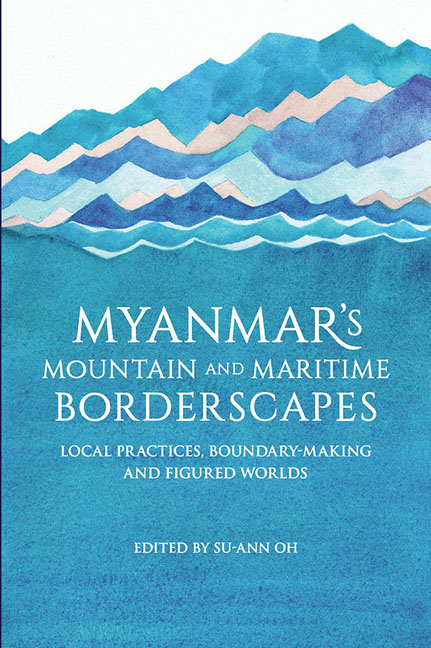Book contents
- Frontmatter
- Contents
- List of Tables
- List of Figures
- Acknowledgements
- Notes on Language, Terminology and Geographical Names
- Contributors
- Abbreviations
- 1 Introduction
- I Overview of Myanmar's Mountain and Maritime Borderscapes
- II Territorial Claims and Imagined Boundaries
- III Social Organization and Border Economies
- IV Mobile Practices and Moving Borders
- V Identity Construction and the Politics of Belonging
- 11 “I Want to Stay Forever in You”
- 12 Life along the Naf Border: Identity Politics of the Rohingya Refugees in Bangladesh
- 13 Home of the Housekeeper: Will Shan Migrants Return after a Decade of Migration?
- 14 Moving on: Spaces of Engagement in the Kayah–Mae Hong Son Borderland
- VI Institutionalized Identity and Border Practices
- Index
12 - Life along the Naf Border: Identity Politics of the Rohingya Refugees in Bangladesh
from V - Identity Construction and the Politics of Belonging
Published online by Cambridge University Press: 06 June 2017
- Frontmatter
- Contents
- List of Tables
- List of Figures
- Acknowledgements
- Notes on Language, Terminology and Geographical Names
- Contributors
- Abbreviations
- 1 Introduction
- I Overview of Myanmar's Mountain and Maritime Borderscapes
- II Territorial Claims and Imagined Boundaries
- III Social Organization and Border Economies
- IV Mobile Practices and Moving Borders
- V Identity Construction and the Politics of Belonging
- 11 “I Want to Stay Forever in You”
- 12 Life along the Naf Border: Identity Politics of the Rohingya Refugees in Bangladesh
- 13 Home of the Housekeeper: Will Shan Migrants Return after a Decade of Migration?
- 14 Moving on: Spaces of Engagement in the Kayah–Mae Hong Son Borderland
- VI Institutionalized Identity and Border Practices
- Index
Summary
INTRODUCTION
The effects of the June 2012 communal violence had barely faded away, when the ethnic Rohingya minority people in northern Rakhine (previously Arakan) State found themselves face-to-face with new existential challenges that included food shortages, malnourishment, and health crises. Amid these challenges, the Myanmar Government quickly swooped in and expelled international aid agencies, whose role was to provide aid to the displaced Rohingya. The Rohingya continue to flee their country in droves, fearing continued persecution and threats to their lives. There are about two million Rohingya in Myanmar, approximately 800,000 of whom live in northern Rakhine State. An estimated 328,500 now live in Bangladesh, as documented and undocumented refugees. About half a million have migrated to other parts of the world. Substantial numbers remain, on either side of the Naf River, where they lead displaced lives and face an uncertain future.
Externally, Myanmar's political transformation appears successful, with a large number of communities having gone “home”, as they say, but the future of the ethnic Rohingya minority remains uncertain. Central to their uncertainty is the question of the group's political identity and hence its belonging. The Myanmar Government considers them “Bengali”, “illegal immigrants”, and “never” having been a part of Myanmar's history. Hence, they ought to be excluded from Myanmar's national identity. Meanwhile, the Bangladeshi Government maintains that the Rohingya were not originally from Bangladesh. They were not officially known until 1977, when they first crossed the border from Myanmar in huge numbers because of political upheaval in their land of origin. Hence, the Bangladeshi Government notes, they are rightfully labelled “refugees” and ought to return. Such political denials on both sides increase the complexity of the situation, and prolong the crisis by pushing the Rohingya back and forth across state boundaries. This makes the border an intriguing part of Rohingya identity.
This chapter has two objectives: firstly, it explores how the state created sociopolitical identities for the Rohingya people in the context of the historical development of Myanmar, and secondly, it examines how the Rohingya people define and construct their own identity given the politics of belonging they are enmeshed in within the context of the Naf border.
- Type
- Chapter
- Information
- Myanmar's Mountain and Maritime BorderscapesLocal Practices, Boundary-Making and Figured Worlds, pp. 283 - 305Publisher: ISEAS–Yusof Ishak InstitutePrint publication year: 2016

